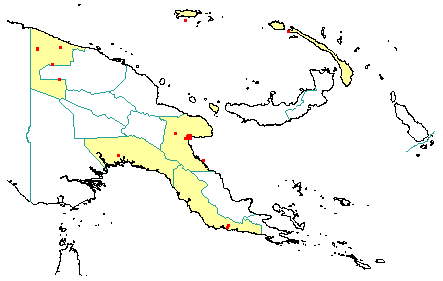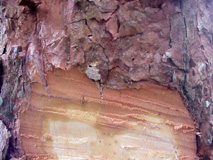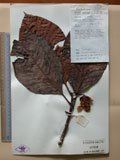
in PNGplants database
PNGTreesKey – Dillenia papuana Martelli |
Barry Conn (NSW) & Kipiro Damas (LAE).
Guide to trees of Papua New Guinea
Copyright held by the authors, National Herbarium of New South Wales, and Papua New Guinea National Herbarium
Malesia Vol. 3: 156 (1886)
Other Literature: R.D. Hoogland, Flora Malesiana, Series 1, 159-161 (1951) Fig. 9.
Family: Dilleniaceae
Dicotyledon
Timber Group: Commercial hardwood
Field Characters: Large canopy tree (20-37 m high); Bole cylindrical (30-80 cm diam.); straight (bole 15-25 m long); buttresses buttresses present (often buttresses up to 4 m high) or buttresses absent; spines spines absent; aerial roots aerial roots absent; stilt roots stilt roots absent; Bark red or reddish brown, slightly rough or smooth, scaly or flaky (thin papery scales) or peeling; Subrhytidome (under-bark) white or pale yellow; less than 25 mm thick, 6.0-18.0; bark blaze consisting of one layer; faintly to non-aromatic; outer blaze pale brown, sometimes markings absent or with stripes, granular without splinters; inner blaze pale brown, sometimes markings absent or with stripes, granular without splinters; bark exudate (sap) present, colourless, not readily flowing (spotty) or flowing, slightly colour changing on exposure to air or colour not changing on exposure to air, to brown, sticky; terminal buds not enclosed by leaves.
Indumentum: Complex hairs absent; stinging hairs absent; mature twig indumentum (hairs) present, hairs dense.
Leaves: Leaves spaced along branches, spiral (leaves occurring singly at a node and arranged spirally up the branchlet), simple (a leaf composed of a single blade); petiole present, not winged or winged when young, attached to base of leaf blade, not swollen; leaves broadest at or near middle or broadest below middle, 15.0-40.0 cm, 10.0-35.0 cm; symmetric, serrate to dentate (toothed) (shortly), not dissected or lobed, rounded to obtuse, venation pinnate (with 18-25 vein-pairs, sometimes as few as 11 vein-pairs), secondary veins open, prominent, intramarginal veins absent; leaves lower surface pale green, upper surface dull dark green, indumentum (hairs) present, indumentum (hairs) dense; absent; domatia present (distinct), scattered along midrib (densely hairy); stipules absent.
Flowers: Inflorescence axillary, flowers on an unbranched axis, cones absent; flowers bisexual, stalked, flowers with many planes of symmetry, 25.0-45.0 mm long, diameter large (more than10 mm diam.); perianth present, with distinct sepals and petals whorls (petals not persistent), inner perianth yellow; 5, free; stamens 180-(pink; anthers with apical appendage up to 5 mm long)-250, present, free of each other, free of the perianth; ovary superior, carpels separate (when more than one) or partially joined, by base, locules 10-15; styles free, 10-15.
Fruits: Infrutescence arranged on unbranched axis, fruit 25.0-35.0 mm long, not spiny, non-fleshy, aggregate, dehiscent, follicle (Each carpel of the flower for a 1-seeded follicle); seeds 10-15, to about 5 mm long, not winged, broad (as wide as long), seed 1-10 mm diam.
Distribution: West Sepik, Morobe, Gulf, Central, New Ireland & Manus.
 | Botanical records in PNGplants database |
iFiles:

 .
.
Notes: Notes This species is morphologically very similar to Dillenia schechteri and Dillenia montana. The bark features of all three species appear to be very similar. Also, the leaves appear to have a similar number of secondary vein-pairs. The slight differences in the shape and size of the petiole wings and apical appendages on the anthers appear to be the only characters that can be used to distinguish between these three species. Further research is required to establish their distinctness. They may represent minor variants of the one species.